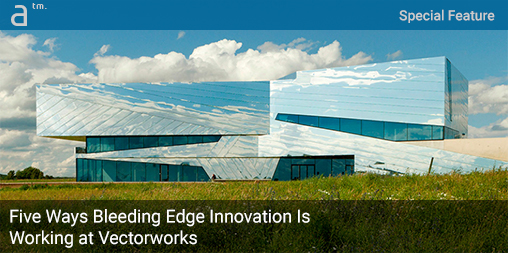Continued from page 2
Augmented Reality and Computer Vision: Impacts on BIM
One of the fruits of the advanced research team’s efforts in the recent past has been Vectorworks’s AR (augmented reality) features. Dr. Sarkar feels the debate about VR versus AR isn’t particularly useful because both are important leading-edge technologies with much forward-looking potential.

02 – Vectorworks 2019 includes post-processing image manipulation for renders. But it intends to use AI and machine learning to advance unique render looks based on the analysis of photos and images.
“Immersive experiences will always be important,” says Sarkar, noting that VR isn’t something that goes away because of AR, “but AR adds a valuable way to convey ideas.” Also, Dr. Sarkar acknowledged that AR perhaps adds more value to the construction side of AEC than on the design side. “People will be using AR more for the construction and facilities maintenance part of a building’s lifecycle.”
With that suggestion, I asked Dr. Sarkar to weigh in on the sensor and 3D photography-based robots emerging on job sites, like Doxel’s technology. In particular, if drones and bots can effectively “see intelligently” and evaluate real-life buildings, what needs to happen to BIM models in order to advance those types of operations?
Our next logical step is to capture real-world data and convert it into models.
“The data that resides in today’s BIM models is kind of static,” Dr. Sarkar explains, “we will need to have some kind of dynamic data attached to building elements that you can query.” He noted that he is a big fan of RFID (radio-frequency identification) tagging and if this RFID data is attached to the BIM model then scanning devices can establish two-way communication with structure and BIM software. Indeed, such systems are similarly happening today, including the use of QR codes on building elements tied into CAFM (computer-aided facilities management) software.
Advertisement
The development of augmented reality (AR) systems is somewhat inseparable from computer vision advances and 3D camera technology. The same technology that reads your face for Apple’s FaceID system is fundamentally capable of reading a building under construction and understanding it in three-dimensions at accuracies up to 3 millimeters.
With advances in AR promising major leaps in user-experiences (UX) and how we interact with technology, Dr. Sarkar says Vectorworks is keeping a close eye on these developments, along with VR. “Our next logical step is to capture real-world data and convert it into models,” he says. In terms of the accuracy advancements made by both lasers and computer vision cameras and software, he says, “I think we are already there.”




Reader Comments
Comments for this story are closed